

Strategies for feeding the world more sustainably with organic agriculture. General description of the SOL-model The SOL-model26 is a bottom-up, mass-flow model of the agricultural production and food sector.
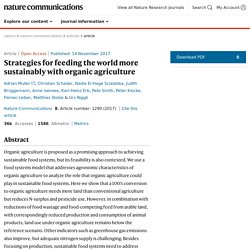
It is calibrated with FAOSTAT data37, in particular the food balance sheets38, and covers all countries and geographic territories as well as commodities covered in FAOSTAT. Given lack of data for a range of those, this amounts to detailed coverage of 180 primary crop and 22 primary livestock activities in 192 countries. Behind this, data on commodity trees from FAOSTAT are used, covering around 700 intermediate products. In the following, only the main aspects and general traits of the SOL-model are presented, as a detailed description is already available elsewhere26. Comparative analysis of environmental impacts of agricultural production systems, agricultural input efficiency, and food choice. Global agricultural feeds over 7 billion people, but is also a leading cause of environmental degradation.
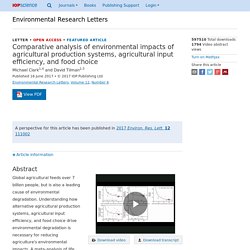
Understanding how alternative agricultural production systems, agricultural input efficiency, and food choice drive environmental degradation is necessary for reducing agriculture's environmental impacts. Gains to species diversity in organically farmed fields are not propagated at the farm level. Study regions and farms Study regions were selected to reflect major organic farming types in Europe and Africa as well as to be spread across a large gradient of climatic conditions (Table 1).

To minimize farm selection bias, the regions needed to be as homogeneous as possible with respect to environmental conditions (soil, temperature and precipitation), while still containing a sufficient number of organic and nonorganic farms. Basic farm information was obtained from local sources (Supplementary Table 1) and specific exclusion criteria were applied to all farms within each study region, for example, a minimum portion of area under arable cropping for farms in regions with mixed land use, a minimum farmed area, a particular livestock type or the cultivation of a particular crop.
Hence, sampled farms were representative for a specific combination of region and agricultural types, for example, vine producers in Veneto, but not for all farms in a region. Species sampling where. Assessing the efficiency of changes in land use for mitigating climate change. The greenhouse gas impacts of converting food production in England and Wales to organic methods. The OLUM The OLUM (Optimal Land Use Model)16 is a linear programming (LP) model that includes a suite of organic farming activities that take place in nine Robust Farm Types: specialist cropping, mixed arable and livestock, specialist dairy, lowland grazing livestock, Less Favoured Area (LFA) grazing livestock, pigs and poultry, and other.
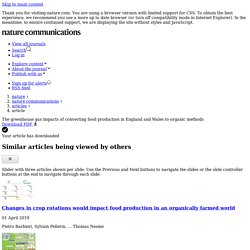
These cover the entire agricultural land-base in England and Wales. The Objective Function of the model, which is maximised subject to constraints on resource availabilities, is the sum of total crop and livestock production, expressed as ME. Although human diets also need proteins, fats and nutrients, energy requirements are deemed to be a primary driver of consumption and an inadequate food-energy intake is almost always accompanied by insufficient intake of nutrients37. The basic formulation of the OLUM is The Agri-LCA models.
The global cropland-sparing potential of high-yield farming. The environmental costs and benefits of high-yield farming. Feeding the World Without Costing the Earth. Gains to species diversity in organically farmed fields are not propagated at the farm level. Does certified organic farming reduce greenhouse gas emissions from agricultural production? Carrying capacity of U.S. agricultural land: Ten diet scenarios. Carbon footprints and land use of conventional and organic diets in Germany. Nature_trewavas_organic. The crop yield gap between organic and conventional agriculture. JavaScript is disabled on your browser.
Ici, on mentionne un rendement 30% inférieur en Europe. Avec le défaut susmentionné de ne pas considérer l'espace pour la production d'intrants. – zetteam
Please enable JavaScript to use all the features on this page.
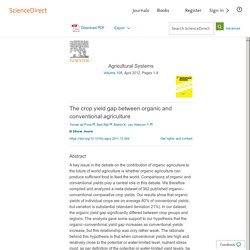
Abstract A key issue in the debate on the contribution of organic agriculture to the future of world agriculture is whether organic agriculture can produce sufficient food to feed the world. Comparisons of organic and conventional yields play a central role in this debate. We therefore compiled and analyzed a meta-dataset of 362 published organic–conventional comparative crop yields. We discuss our findings in the context of the literature on this subject and address the issue of upscaling our results to higher system levels. Highlights Keywords. Méta-analyse complète sur l'impact de l'AB → voir commentaire.
Does organic farming reduce environmental impacts? – A meta-analysis of European research. JavaScript is disabled on your browser.
Europe. "Median response ratio showed that organic farming requires 84% more land compared to conventional farming in Europe (Figs. 1C and 4A). This is mainly due to lower crop yields, lower yielding animals and land area requirement for fertility building crops. The average organic yields over all crops in the data were 75% (SD ± 17%) of conventional yields (Table 2). In only in two cases were the organic yields higher, both of which related to melon production (Melero et al., 2006). The main reason for lower organic yields identified in the studies was insufficient availability of nutrients (especially nitrogen) although some studies mentioned problems with weeds, diseases or pests (Korsaeth, 200😎.+ – zetteam
Please enable JavaScript to use all the features on this page.
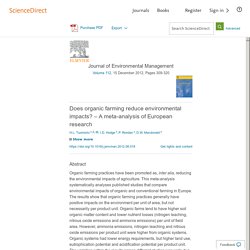
Abstract. Comparing the yields of organic and conventional agriculture.